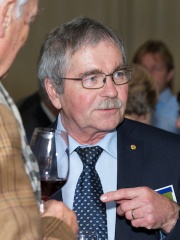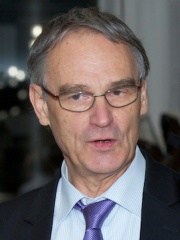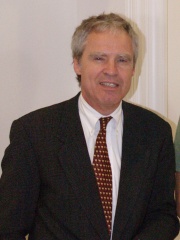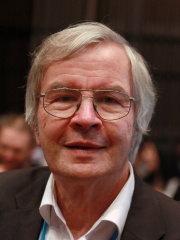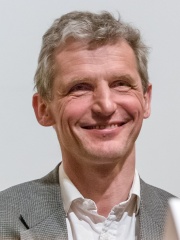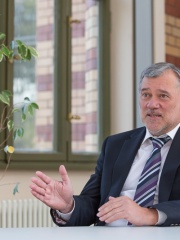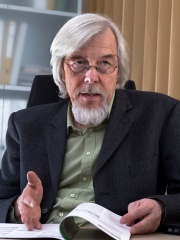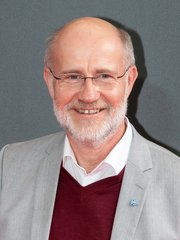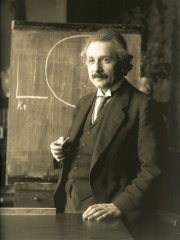
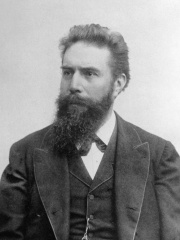

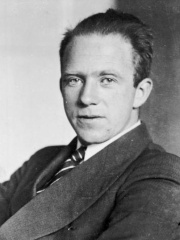

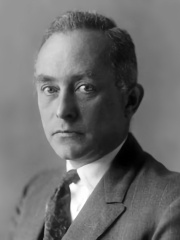
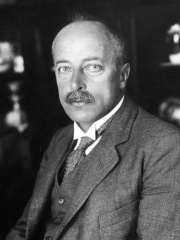
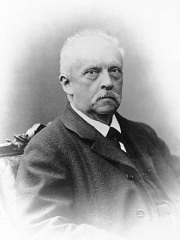
The Most Famous
PHYSICISTS from Germany
This page contains a list of the greatest German Physicists. The pantheon dataset contains 851 Physicists, 107 of which were born in Germany. This makes Germany the birth place of the 2nd most number of Physicists.
Top 10
The following people are considered by Pantheon to be the top 10 most legendary German Physicists of all time. This list of famous German Physicists is sorted by HPI (Historical Popularity Index), a metric that aggregates information on a biography's online popularity. Visit the rankings page to view the entire list of German Physicists.

1. Albert Einstein (1879 - 1955)
With an HPI of 94.83, Albert Einstein is the most famous German Physicist. His biography has been translated into 228 different languages on wikipedia.
Albert Einstein (14 March 1879 – 18 April 1955) was a German-born theoretical physicist best known for developing the theory of relativity. Einstein also made important contributions to quantum theory. His mass–energy equivalence formula E = mc2, which arises from special relativity, has been called "the world's most famous equation". He received the 1921 Nobel Prize in Physics for "his services to theoretical physics, and especially for his discovery of the law of the photoelectric effect". Born in the German Empire, Einstein moved to Switzerland in 1895, forsaking his German citizenship (as a subject of the Kingdom of Württemberg) the following year. In 1897, at the age of seventeen, he enrolled in the mathematics and physics teaching diploma program at the Swiss federal polytechnic school in Zurich, graduating in 1900. He acquired Swiss citizenship a year later, which he kept for the rest of his life, and afterwards secured a permanent position at the Swiss Patent Office in Bern. In 1905, he submitted a successful PhD dissertation to the University of Zurich. In 1914, he moved to Berlin to join the Prussian Academy of Sciences and the Humboldt University of Berlin, becoming director of the Kaiser Wilhelm Institute for Physics in 1917; he also became a German citizen again, this time as a subject of the Kingdom of Prussia. In 1933, while Einstein was visiting the United States, Adolf Hitler came to power in Germany. Horrified by the Nazi persecution of his fellow Jews, he decided to remain in the US, and was granted American citizenship in 1940. On the eve of World War II, he endorsed a letter to President Franklin D. Roosevelt alerting him to the potential German nuclear weapons program and recommending that the US begin similar research, later carried out as the Manhattan Project. In 1905, sometimes described as his annus mirabilis (miracle year), he published four groundbreaking papers. In them, he outlined a theory of the photoelectric effect, explained Brownian motion, introduced his special theory of relativity, and demonstrated that if the special theory is correct, mass and energy are equivalent to each other. In 1915, he proposed a general theory of relativity that extended his system of mechanics to incorporate gravitation. A cosmological paper that he published the following year laid out the implications of general relativity for the modeling of the structure and evolution of the universe as a whole. In 1917, Einstein wrote a paper which introduced the concepts of spontaneous emission and stimulated emission, the latter of which is the core mechanism behind the laser and maser, and which contained a trove of information that would be beneficial to developments in physics later on, such as quantum electrodynamics and quantum optics. In the middle part of his career, Einstein made important contributions to statistical mechanics and quantum theory. Especially notable was his work on the quantum physics of radiation, in which light consists of particles, subsequently called photons. With physicist Satyendra Nath Bose, he laid the groundwork for Bose–Einstein statistics. For much of the last phase of his academic life, Einstein worked on two endeavors that ultimately proved unsuccessful. First, he advocated against quantum theory's introduction of fundamental randomness into science's picture of the world, objecting that "God does not play dice". Second, he attempted to devise a unified field theory by generalizing his geometric theory of gravitation to include electromagnetism. As a result, he became increasingly isolated from mainstream modern physics.

2. Wilhelm Röntgen (1845 - 1923)
With an HPI of 87.15, Wilhelm Röntgen is the 2nd most famous German Physicist. His biography has been translated into 139 different languages.
Wilhelm Conrad Röntgen ( RENT-guhn, RUHNT-; German: [ˈvɪlhɛlm ˈʁœntɡən] ; 27 March 1845 – 10 February 1923), sometimes transliterated as Roentgen, was a German experimental physicist who produced and detected electromagnetic radiation in a wavelength range known as X-rays. For this discovery, he became the first recipient of the Nobel Prize in Physics in 1901.

3. Max Planck (1858 - 1947)
With an HPI of 85.41, Max Planck is the 3rd most famous German Physicist. His biography has been translated into 147 different languages.
Max Karl Ernst Ludwig Planck (German: [maks ˈplaŋk] ; 23 April 1858 – 4 October 1947) was a German theoretical physicist whose discovery of energy quanta won him the Nobel Prize in Physics in 1918. Planck made many substantial contributions to theoretical physics, but his fame as a physicist rests primarily on his role as the originator of quantum theory and one of the founders of modern physics, which revolutionized understanding of atomic and subatomic processes. He is known for the Planck constant, which is of foundational importance for quantum physics, and which he used to derive a set of units, now called Planck units, expressed only in terms of physical constants. Planck was twice President of the Kaiser Wilhelm Society. In 1948 it was renamed the Max Planck Society, and today includes 83 institutions representing a wide range of scientific directions.

4. Werner Heisenberg (1901 - 1976)
With an HPI of 83.50, Werner Heisenberg is the 4th most famous German Physicist. His biography has been translated into 113 different languages.
Werner Karl Heisenberg (; German: [ˈvɛʁnɐ ˈhaɪzn̩bɛʁk] ; 5 December 1901 – 1 February 1976) was a German theoretical physicist, one of the main pioneers of the theory of quantum mechanics and a principal scientist in the German nuclear program during World War II. Heisenberg published his Umdeutung paper in 1925, a major reinterpretation of old quantum theory. In the subsequent series of papers with Max Born and Pascual Jordan, during the same year, his matrix formulation of quantum mechanics was substantially elaborated. He is known for the uncertainty principle, which he published in 1927. He received the Nobel Prize in Physics in 1932 "for the creation of quantum mechanics". Heisenberg also made contributions to the theories of the hydrodynamics of turbulent flows, the atomic nucleus, ferromagnetism, cosmic rays, and subatomic particles. He introduced the concept of a wave function collapse. He was also instrumental in planning the first West German nuclear reactor in Karlsruhe, together with a research reactor in Munich, in 1957. Following World War II, Heisenberg was appointed Director of the Kaiser Wilhelm Institute for Physics, which soon thereafter was renamed the Max Planck Institute for Physics. He was director until it was moved to Munich in 1958. He was Director of the Max Planck Institute for Physics and Astrophysics from 1960 to 1970. Heisenberg was also President of the German Research Council, Chairman of the Commission for Atomic Physics, Chairman of the Nuclear Physics Working Group, and President of the Alexander von Humboldt Foundation.
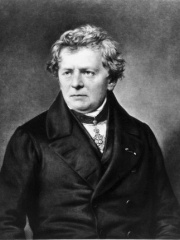
5. Georg Ohm (1789 - 1854)
With an HPI of 83.08, Georg Ohm is the 5th most famous German Physicist. His biography has been translated into 96 different languages.
Georg Simon Ohm (; German: [oːm] ; 16 March 1789 – 6 July 1854) was a German mathematician and physicist. As a school teacher, Ohm began his research with the new electrochemical cell, invented by Italian scientist Alessandro Volta. Using equipment of his own creation, Ohm found that there is a direct proportionality between the potential difference (voltage) applied across a conductor and the resultant electric current; this relation is known as Ohm's law.

6. Heinrich Hertz (1857 - 1894)
With an HPI of 82.34, Heinrich Hertz is the 6th most famous German Physicist. His biography has been translated into 101 different languages.
Heinrich Rudolf Hertz ( hurts; German: [hɛʁts] ; 22 February 1857 – 1 January 1894) was a German physicist who first conclusively proved the existence of the electromagnetic waves proposed by James Clerk Maxwell's equations of electromagnetism.

7. Max Born (1882 - 1970)
With an HPI of 78.04, Max Born is the 7th most famous German Physicist. His biography has been translated into 99 different languages.
Max Born (German: [ˈmaks ˈbɔʁn] ; 11 December 1882 – 5 January 1970) was a German–British theoretical physicist who was instrumental in the development of quantum mechanics. He also made contributions to solid-state physics and optics, and supervised the work of a number of notable physicists in the 1920s and 1930s. He shared the 1954 Nobel Prize in Physics with Walther Bothe "for his fundamental research in quantum mechanics, especially in the statistical interpretation of the wave function." Born entered the University of Goettingen in 1904, where he met the three renowned mathematicians Felix Klein, David Hilbert, and Hermann Minkowski. He wrote his Ph.D. thesis on the subject of the stability of elastic wires and tapes, winning the university's Philosophy Faculty Prize. In 1905, he began researching special relativity with Minkowski, and subsequently wrote his habilitation thesis on the Thomson model of the atom. A chance meeting with Fritz Haber in Berlin in 1918 led to discussion of how an ionic compound is formed when a metal reacts with a halogen, which is now known as the Born–Haber cycle. During World War I, Born was originally placed as a radio operator, but his specialist knowledge led to his being moved to research duties on sound ranging. In 1921 Born returned to Göttingen, where he arranged another chair for his long-time friend and colleague James Franck. Under Born, Göttingen became one of the world's foremost centres for physics. In 1925, Born and Werner Heisenberg formulated the matrix mechanics representation of quantum mechanics. The following year, he formulated the now-standard interpretation of the probability density function for ψ*ψ in the Schrödinger equation, for which he was awarded the Nobel Prize in 1954. His influence extended far beyond his own research: Max Delbrück, Siegfried Flügge, Friedrich Hund, Pascual Jordan, Maria Goeppert Mayer, Lothar Nordheim, Robert Oppenheimer, and Victor Weisskopf all received their Ph.D. degrees under Born at Göttingen, and his assistants included Enrico Fermi, Werner Heisenberg, Gerhard Herzberg, Friedrich Hund, Wolfgang Pauli, Léon Rosenfeld, Edward Teller, and Eugene Wigner. In January 1933, when the Nazi Party came to power in Germany, Born, who was Jewish, was suspended from his professorship at the University of Göttingen. He emigrated to the United Kingdom, where he took a job at St. John's College, Cambridge, and wrote a popular science book, The Restless Universe, as well as Atomic Physics, which soon became a standard textbook. In October 1936, he was appointed Tait Professor of Natural Philosophy at the University of Edinburgh, where, working with German-born assistants E. Walter Kellermann and Klaus Fuchs, he continued his research into physics. He became a naturalised British subject on 31 August 1939, one day before World War II broke out in Europe. He remained in Edinburgh until 1952, when he retired to Bad Pyrmont, West Germany, and died in a hospital in Goettingen on 5 January 1970.

8. Max von Laue (1879 - 1960)
With an HPI of 77.54, Max von Laue is the 8th most famous German Physicist. His biography has been translated into 86 different languages.
Max Theodor Felix von Laue (German: [maks fɔn ˈlaʊ̯ə] ; 9 October 1879 – 24 April 1960) was a German physicist who received the Nobel Prize in Physics in 1914 "for his discovery of the diffraction of X-rays by crystals". In addition to his scientific endeavors with contributions in optics, crystallography, quantum theory, superconductivity, and the theory of relativity, Laue had a number of administrative positions which advanced and guided German scientific research and development during four decades. A strong objector to Nazism, he was instrumental in re-establishing and organizing German science after World War II.

9. Hermann von Helmholtz (1821 - 1894)
With an HPI of 77.32, Hermann von Helmholtz is the 9th most famous German Physicist. His biography has been translated into 72 different languages.
Hermann Ludwig Ferdinand von Helmholtz (; German: [ˈhɛʁman fɔn ˈhɛlmˌhɔlts]; 31 August 1821 – 8 September 1894; "von" since 1883) was a German physicist and physician who made significant contributions in several scientific fields, particularly hydrodynamic stability. The Helmholtz Association, the largest German association of research institutions, was named in his honour. In the fields of physiology and psychology, Helmholtz is known for his mathematics concerning the eye, theories of vision, ideas on the visual perception of space, colour vision research, the sensation of tone, perceptions of sound, and empiricism in the physiology of perception. In physics, he is known for his theories on the conservation of energy and on the electrical double layer, work in electrodynamics, chemical thermodynamics, and on a mechanical foundation of thermodynamics. Although credit is shared with Julius von Mayer, James Joule, and Daniel Bernoulli—among others—for the energy conservation principles that eventually led to the first law of thermodynamics, he is credited with the first formulation of the energy conservation principle in its maximally general form. As a philosopher, he is known for his philosophy of science, ideas on the relation between the laws of perception and the laws of nature, the science of aesthetics, and ideas on the civilizing power of science. By the late nineteenth century, Helmholtz's development of a broadly Kantian methodology, including the a priori determination of the manifold of possible orientations in perceptual space, had inspired new readings of Kant and contributed to the late modern neo-Kantianism movement in philosophy.
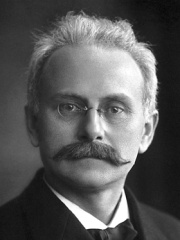
10. Johannes Stark (1874 - 1957)
With an HPI of 76.77, Johannes Stark is the 10th most famous German Physicist. His biography has been translated into 83 different languages.
Johannes Stark (German: [joˈhanəs ˈʃtaʁk] ; 15 April 1874 – 21 June 1957) was a German physicist who received the Nobel Prize in Physics in 1919 for his discovery of the Stark effect. A supporter of Adolf Hitler from 1924, Stark was one of the main figures, along with fellow Nobel laureate Philipp Lenard, in the antisemitic Deutsche Physik movement, which sought to remove Jewish physicists from German institutions. In 1947, he was found guilty as a "Major Offender" by a denazification court, but this was reduced to "Lesser Offender" in 1949 after appeal.
People
Pantheon has 108 people classified as German physicists born between 1575 and 1976. Of these 108, 12 (11.11%) of them are still alive today. The most famous living German physicists include Georg Bednorz, Gerd Binnig, and Horst Ludwig Störmer. The most famous deceased German physicists include Albert Einstein, Wilhelm Röntgen, and Max Planck. As of April 2024, 1 new German physicists have been added to Pantheon including Harald Lesch.
Living German Physicists
Go to all RankingsGeorg Bednorz
1950 - Present
HPI: 76.58
Gerd Binnig
1947 - Present
HPI: 73.15
Horst Ludwig Störmer
1949 - Present
HPI: 71.83
Theodor W. Hänsch
1941 - Present
HPI: 71.55
Klaus Hasselmann
1931 - Present
HPI: 67.74
Wolfgang Ketterle
1957 - Present
HPI: 64.61
Jürgen Kurths
1953 - Present
HPI: 54.52
Rolf-Dieter Heuer
1948 - Present
HPI: 53.55
Sabine Hossenfelder
1976 - Present
HPI: 48.55
Harald Lesch
1960 - Present
HPI: 48.46
Gabriele Hegerl
1962 - Present
HPI: 48.01
Katherine Freese
1957 - Present
HPI: 44.21
Deceased German Physicists
Go to all RankingsAlbert Einstein
1879 - 1955
HPI: 94.83
Wilhelm Röntgen
1845 - 1923
HPI: 87.15
Max Planck
1858 - 1947
HPI: 85.41
Werner Heisenberg
1901 - 1976
HPI: 83.50
Georg Ohm
1789 - 1854
HPI: 83.08
Heinrich Hertz
1857 - 1894
HPI: 82.34
Max Born
1882 - 1970
HPI: 78.04
Max von Laue
1879 - 1960
HPI: 77.54
Hermann von Helmholtz
1821 - 1894
HPI: 77.32
Johannes Stark
1874 - 1957
HPI: 76.77
Gustav Ludwig Hertz
1887 - 1975
HPI: 76.77
Otto von Guericke
1602 - 1686
HPI: 76.40
Newly Added German Physicists (2025)
Go to all RankingsOverlapping Lives
Which Physicists were alive at the same time? This visualization shows the lifespans of the 25 most globally memorable Physicists since 1700.

